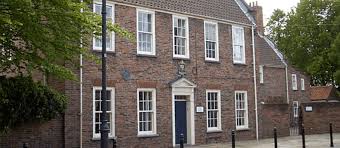There had been a a religious house to the north of the walls of Hull since the time of Edward I (Late 13th Century). In the 14th Century the land belonged to William De La Pole and he built a hospital there around 1350, and its name was Maison Dieu, God's House. De La Pole got a licence from the Pope to build a monastry but died before it was completed. His son Michael completed it in 1377 and it was dedicated to St Michael and housed monks for the Carthusian Order.
Despite doing well with an income £230 it was not dissolved by Henry VIII in 1535, only to fall prey in 1538. The priory was destroyed but the hospital survived as it was already held by the crown due to supposed misdeeds of Edmund De La Pole who had a claim to the throne of Henry VII and tried to bring help from abroad. The hospital was given back to the Hull Corporation in 1553. It became known as the Charterhouse after the Priory.
These buildings were pulled down before the first siege of Hull, in 1642, during the English Civil War and the area used as a battery of two guns to protect the city walls. The inmates moved to Whitefriar Gate with in the walls of the town. The place was rebuilt in 1645 at a cost of £474 and further cells and rooms added in 1663 and 1673. In 1780 the complex was again rebuilt and the current buildings are from these times. It was extended further in 1803.






Despite doing well with an income £230 it was not dissolved by Henry VIII in 1535, only to fall prey in 1538. The priory was destroyed but the hospital survived as it was already held by the crown due to supposed misdeeds of Edmund De La Pole who had a claim to the throne of Henry VII and tried to bring help from abroad. The hospital was given back to the Hull Corporation in 1553. It became known as the Charterhouse after the Priory.
These buildings were pulled down before the first siege of Hull, in 1642, during the English Civil War and the area used as a battery of two guns to protect the city walls. The inmates moved to Whitefriar Gate with in the walls of the town. The place was rebuilt in 1645 at a cost of £474 and further cells and rooms added in 1663 and 1673. In 1780 the complex was again rebuilt and the current buildings are from these times. It was extended further in 1803.

The Charterhouse from 1780.
The Master's House also from 1780. This buildings are said to have parts of the 1600's buildings incorporated within.

The Charterhouse was damaged on the first raid of the war in Hull and wasn't repaired until 1950.
The Hull poet Andrew Marvel was brought up here as his Father was the Master of the School here.

The 18th Century Chapel within the Charterhouse.

Detail below the entrance porch.
The Charterhose still serves as Alms houses providing accommodation for up to 40 people in one or two bedroom flats, half on the ground floor. Rent is a very reasonable £64/74.

The accommodation at Charthouse.
The Charterhouse is in a very quiet area of the city that is a short walk away from the city centre and is well worth a visit.
No comments:
Post a Comment